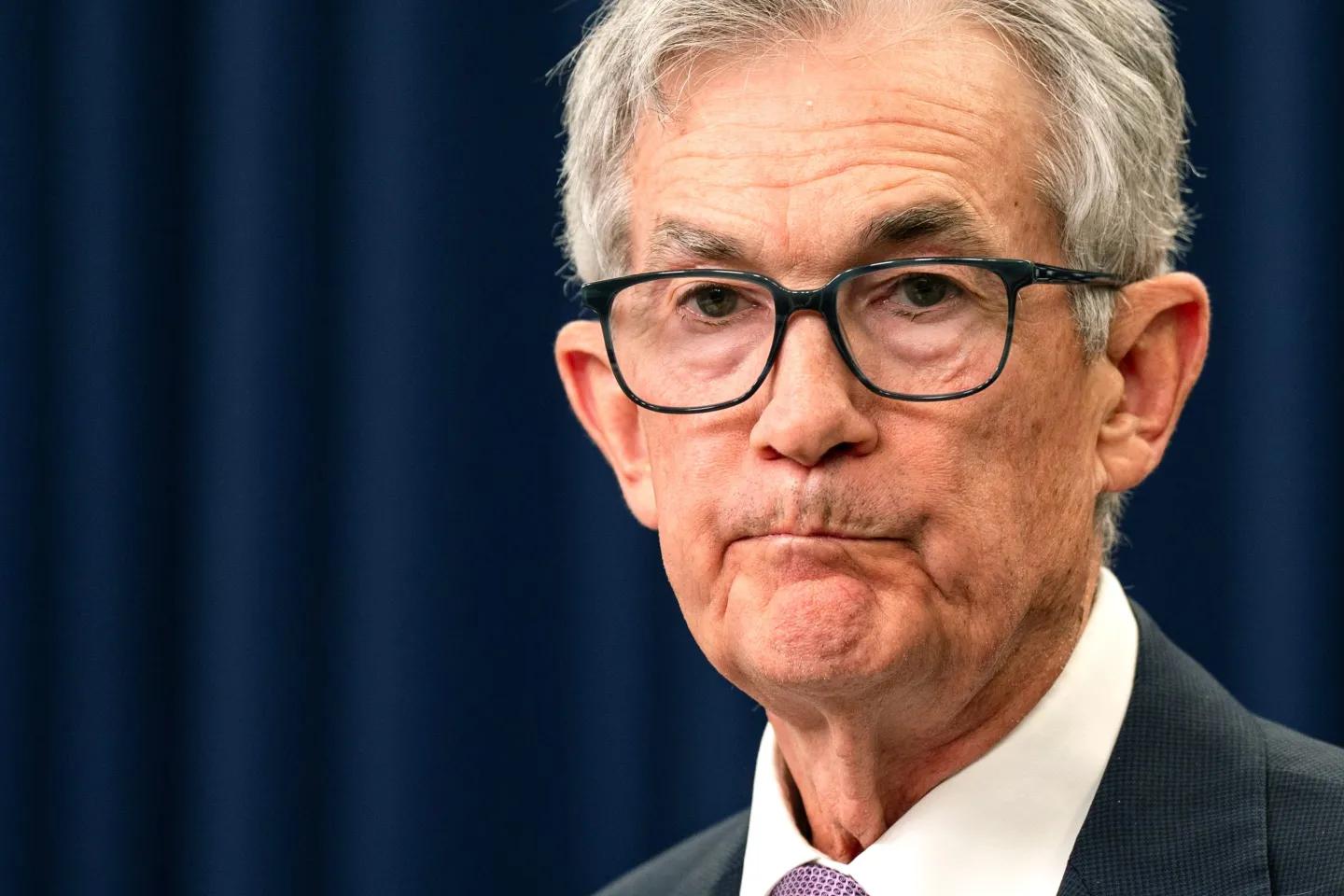
新鲜出炉的美国通胀数据可能让美联储(Federal Reserve)在降息速度上更加谨慎,但它目前还没有这样做。
在媒体报道11月美国的通胀符合预期之后,投资者普遍预测美联储将在下周将借贷利率下调25个基点。但持续的价格压力也凸显了人们的担忧,即实现美联储2%通胀目标的进程可能会陷入停滞。
这些担忧可能令美联储控制在2025年的预期降息次数,因为他们要进一步确认通胀正在朝着他们的目标前进。政策制定者将在12月17日至18日华盛顿会议结束时,公布新的预期和利率预测。
前克利夫兰联邦储备银行(Cleveland Fed)总裁洛雷塔·梅斯特表示:“我认为他们在12月一定会继续降息25个基点。市场已经为此做好了准备。然而,他们可能要重新考虑明年的计划,因为现在看来,控制通胀的进程确实有所停滞。”
就在三个月前,随着对美国劳动力市场降温接近危险临界点的担忧日益加剧,美联储开始了降息周期,大幅降息50个基点。下周的降息将是美联储连续第3次降息,将把联邦基金利率下调至4.25%至4.5%的区间,比9月初整整下降一个百分点。
但这依旧远远高于政策制定者在9月份预估的2.9%的利率中位数,当时他们预测利率最终将稳定在这个水平。美联储并不急于达成这个目标。
这是因为自9月以来,通胀下降速度低于预期,而且劳动力市场也没有像人们所担心的那么疲软。对于这种情况,包括杰罗姆·鲍威尔在内的美联储官员均暗示,他们准备慢慢降低借贷成本。
如果政策制定者保持9月份的预测不变,这意味着在今年12月份的降息之后,美联储将在2025年再进行4次降息。但许多分析师预测,由于对顽固性通胀的担忧加剧,特别是在美联储下周坚持降息的情况下,美联储在2025年可能会减少降息次数。
Brean Capital LLC高级经济顾问康拉德·德卡德罗斯表示:“支持降息的‘鸽派’将为此付出代价,在预测中不得不接受更高的利率路径。我们会看到美联储降息,但未来降息的幅度会大幅下降。”
根据联邦基金期货的定价,投资者认为在美联储12月降息后,明年还会有两到三次降息。
MacroPolicy Perspectives创始人、前美联储经济学家茱莉亚·科罗纳多认为,有多位美联储官员可能会减少2025年的预期降息次数。
科罗纳多表示:“他们在基准情景预测中减少宽松政策是合理的。但问题在于‘好吧,那么时间安排呢?’”
更强劲的数据
美国劳工统计局(Bureau of Labor Statistics)周三发布的11月份数据显示,剔除波动较大的食品和能源成本的核心通胀连续4个季度上涨了0.3%。与一年前相比,核心通胀率上涨了3.3%。
上个月,导致通胀居高不下的住房成本有所回落。但剔除食品和能源的商品价格(此前成本一直在下降)上涨了0.3%,创下自2023年5月以来的最大涨幅。
交易员的反应是,将美联储下周降息的概率从通胀数据发布前的约80%提高至约90%。
马尔堡投资管理公司(Marlborough Investment Management)的投资组合经理詹姆斯·阿西表示:“12月份降息似乎已经板上钉钉,而且美联储不是那种喜欢给市场带来惊喜的央行。”
短期美国国债最初大幅上涨,但数据公布当天晚些时候回吐了这些涨幅。由于周五公布的11月份就业数据喜忧参半,债券多头在本周初信心大增,这使得美联储今年再次降息的可能性大增。
彭博经济(Bloomberg Economics)的专家怎么说……
“11月强劲的核心CPI数据将加剧联邦公开市场委员会少数成员对通货紧缩停滞的担忧。确实,正如市场租金长期以来所预示的那样,住房租金通胀最终有所回落,但商品价格的通胀放缓势头已经减弱。
—— 安娜·黄与斯图尔特·保罗,经济学家
更强劲的通胀数据也让更多人质疑,当前中性利率(既不会减缓也不会刺激经济的借贷成本)是否变得更高。如果中性利率升高,这意味着利率并没有像之前预测的那样,给经济带来太大下行压力。
美联储的官员不希望利率造成太多限制,以免给劳动力市场造成损害,但他们也不希望过快降息,以免利率低于中性水平并再次引发通胀。
鲍威尔上周表示:“在寻找中性利率的过程中,我们可以更加谨慎一些。”(财富中文网)
译者:刘进龙
审校:汪皓
新鲜出炉的美国通胀数据可能让美联储(Federal Reserve)在降息速度上更加谨慎,但它目前还没有这样做。
在媒体报道11月美国的通胀符合预期之后,投资者普遍预测美联储将在下周将借贷利率下调25个基点。但持续的价格压力也凸显了人们的担忧,即实现美联储2%通胀目标的进程可能会陷入停滞。
这些担忧可能令美联储控制在2025年的预期降息次数,因为他们要进一步确认通胀正在朝着他们的目标前进。政策制定者将在12月17日至18日华盛顿会议结束时,公布新的预期和利率预测。
前克利夫兰联邦储备银行(Cleveland Fed)总裁洛雷塔·梅斯特表示:“我认为他们在12月一定会继续降息25个基点。市场已经为此做好了准备。然而,他们可能要重新考虑明年的计划,因为现在看来,控制通胀的进程确实有所停滞。”
就在三个月前,随着对美国劳动力市场降温接近危险临界点的担忧日益加剧,美联储开始了降息周期,大幅降息50个基点。下周的降息将是美联储连续第3次降息,将把联邦基金利率下调至4.25%至4.5%的区间,比9月初整整下降一个百分点。
但这依旧远远高于政策制定者在9月份预估的2.9%的利率中位数,当时他们预测利率最终将稳定在这个水平。美联储并不急于达成这个目标。
这是因为自9月以来,通胀下降速度低于预期,而且劳动力市场也没有像人们所担心的那么疲软。对于这种情况,包括杰罗姆·鲍威尔在内的美联储官员均暗示,他们准备慢慢降低借贷成本。
如果政策制定者保持9月份的预测不变,这意味着在今年12月份的降息之后,美联储将在2025年再进行4次降息。但许多分析师预测,由于对顽固性通胀的担忧加剧,特别是在美联储下周坚持降息的情况下,美联储在2025年可能会减少降息次数。
Brean Capital LLC高级经济顾问康拉德·德卡德罗斯表示:“支持降息的‘鸽派’将为此付出代价,在预测中不得不接受更高的利率路径。我们会看到美联储降息,但未来降息的幅度会大幅下降。”
根据联邦基金期货的定价,投资者认为在美联储12月降息后,明年还会有两到三次降息。
MacroPolicy Perspectives创始人、前美联储经济学家茱莉亚·科罗纳多认为,有多位美联储官员可能会减少2025年的预期降息次数。
科罗纳多表示:“他们在基准情景预测中减少宽松政策是合理的。但问题在于‘好吧,那么时间安排呢?’”
更强劲的数据
美国劳工统计局(Bureau of Labor Statistics)周三发布的11月份数据显示,剔除波动较大的食品和能源成本的核心通胀连续4个季度上涨了0.3%。与一年前相比,核心通胀率上涨了3.3%。
上个月,导致通胀居高不下的住房成本有所回落。但剔除食品和能源的商品价格(此前成本一直在下降)上涨了0.3%,创下自2023年5月以来的最大涨幅。
交易员的反应是,将美联储下周降息的概率从通胀数据发布前的约80%提高至约90%。
马尔堡投资管理公司(Marlborough Investment Management)的投资组合经理詹姆斯·阿西表示:“12月份降息似乎已经板上钉钉,而且美联储不是那种喜欢给市场带来惊喜的央行。”
短期美国国债最初大幅上涨,但数据公布当天晚些时候回吐了这些涨幅。由于周五公布的11月份就业数据喜忧参半,债券多头在本周初信心大增,这使得美联储今年再次降息的可能性大增。
彭博经济(Bloomberg Economics)的专家怎么说……
“11月强劲的核心CPI数据将加剧联邦公开市场委员会少数成员对通货紧缩停滞的担忧。确实,正如市场租金长期以来所预示的那样,住房租金通胀最终有所回落,但商品价格的通胀放缓势头已经减弱。
—— 安娜·黄与斯图尔特·保罗,经济学家
更强劲的通胀数据也让更多人质疑,当前中性利率(既不会减缓也不会刺激经济的借贷成本)是否变得更高。如果中性利率升高,这意味着利率并没有像之前预测的那样,给经济带来太大下行压力。
美联储的官员不希望利率造成太多限制,以免给劳动力市场造成损害,但他们也不希望过快降息,以免利率低于中性水平并再次引发通胀。
鲍威尔上周表示:“在寻找中性利率的过程中,我们可以更加谨慎一些。”(财富中文网)
译者:刘进龙
审校:汪皓
Federal Reserve Board Federal Reserve Chairman Jerome Powell speaks during a news conference following a Federal Open Market Committee meeting in Washington on November 07, 2024 in Washington, DC.
Fresh inflation figures are likely to make the Federal Reserve more cautious about the pace of interest-rate cuts — but not quite yet.
Investors still widely expect the US central bank to cut borrowing costs by a quarter percentage point next week after a new report showed inflation rose in November in line with expectations. But persistent price pressures have also underscored concerns that progress toward the US central bank’s 2% target may be stalling.
Those concerns could prompt officials to rein in the number of rate cuts they anticipate in 2025 as they wait for more confirmation that inflation is on track to reach their goal. Policymakers will release new forecasts and rate projections at the conclusion of their Dec. 17-18 meeting in Washington.
“I think they can safely go ahead and do a 25-basis-point cut in December. The markets are prepared for that,” said Loretta Mester, a former president of the Cleveland Fed. “However, they’ve got to be rethinking about next year, because it does look now that the inflation progress has stalled out a bit.”
Just three months ago, the Fed kicked off its cutting cycle with an aggressive half-point move driven by growing worries that a cooling US labor market was nearing a dangerous tipping point. A cut next week would be the Fed’s third straight reduction and lower the federal funds rate to a range of 4.25% to 4.5%, a full percentage point below where it stood at the beginning of September.
That’s still well above the 2.9% median estimate submitted by policymakers in September for where they see rates ultimately settling. They’re just not in as much of a hurry to get there.
That’s because, since September, inflation has moved down more slowly than expected and the labor market hasn’t weakened as much as feared. Officials, including Chair Jerome Powell, have responded by signaling they’re prepared to take their time lowering borrowing costs.
If policymakers were to leave their projections from September unchanged, that would point to four more reductions in 2025, after a December reduction. But many analysts expect the 2025 number will drop because of growing worries over inflation’s stickiness, especially if the committee follows through with a rate cut next week.
“The doves who want the rate cut are going to pay for it with a higher path” in the forecasts, said Conrad DeQuadros, senior economic adviser at Brean Capital LLC. “We will get the cut, but the path going forward will be a much shallower path.”
Investors, based on pricing in fed funds futures, see a December cut followed by two to three additional cuts next year.
Julia Coronado, founder of MacroPolicy Perspectives and a former Fed economist, agreed that several officials could reduce the number of cuts they see in 2025.
“It makes sense that they should maybe have less easing in their baseline than in September,” said Coronado. “And then the question then becomes, ‘alright, but what about timing?’”
Stronger data
The November data released Wednesday by the Bureau of Labor Statistics showed core consumer inflation, which excludes volatile food and energy costs, rose by 0.3% for the fourth straight month. From a year ago, it rose 3.3%.
Shelter costs, a source of stubborn inflation, cooled from the previous month. But goods prices excluding food and energy, an area where costs had been falling, climbed 0.3%, the most since May 2023.
Traders reacted by ramping up to about 90% the probability they see of the Fed cutting rates next week, boosting those odds from around 80% prior to the inflation release.
“December looks nailed down now, and the Fed isn’t one of those central banks that likes to surprise the market,” said James Athey, a portfolio manager at Marlborough Investment Management.
Short-term US Treasuries intially rallied sharply before pairing those gains later in the day. Bond bulls had come into the week emboldened given Friday’s job data for November was mixed and made one more cut from the Fed this year seem more likely.
What Bloomberg Economics Says…
“November’s sturdy core CPI reading will inflame worries among the FOMC minority that disinflation has stalled. True, housing-rent inflation finally stepped down — as market rents have long suggested — but goods prices have lost disinflation momentum.”
— Anna Wong and Stuart Paul, economists
Stronger inflation data could also add to questions about whether the neutral rate — the level for borrowing costs that neither slows nor stimulates the economy — is now higher. If the neutral level is now more elevated, that would suggest that interest rates are not putting as much downward pressure on the economy as previously expected.
Officials do not want interest rates to be so restrictive that they cause damage to the labor market, but they also don’t want to cut so quickly that they risk moving below neutral and reigniting inflation.
“We can afford to be a little more cautious as we try to find neutral,” Powell said last week.






